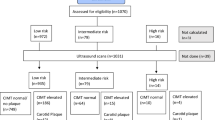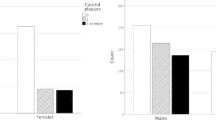Abstract
Ultrasound detection of sub-clinical atherosclerosis (ATS) may help identify individuals at high cardiovascular risk. Most studies evaluated intima-media thickness (IMT) at carotid level. We compared the relationships between main cardiovascular risk factors (CVRF) and five indicators of ATS (IMT, mean and maximal plaque thickness, mean and maximal plaque area) at both carotid and femoral levels. Ultrasound was performed on 496 participants aged 45–64 years randomly selected from the general population of the Republic of Seychelles. 73.4 % participants had ≥1 plaque (IMT thickening ≥1.2 mm) at carotid level and 67.5 % at femoral level. Variance (adjusted R2) contributed by age, sex and CVRF (smoking, LDL-cholesterol, HDL-cholesterol, blood pressure, diabetes) in predicting any of the ATS markers was larger at femoral than carotid level. At both carotid and femoral levels, the association between CVRF and ATS was stronger based on plaque-based markers than IMT. Our findings show that the associations between CVRF and ATS markers were stronger at femoral than carotid level, and with plaque-based markers rather than IMT. Pending comparison of these markers using harder cardiovascular endpoints, our findings suggest that markers based on plaque morphology assessed at femoral artery level might be useful cardiovascular risk predictors.

Similar content being viewed by others
References
van der Meer I, Bots M, Hofman A, Iglesias del Sol A, van der Kuip D, Witteman J (2004) Predictive value of noninvasive measures of atherosclerosis for incident myocardial infraction. The Rotterdam study. Circulation 109:1089–1094
Lorenz M, Markus HS, Bots ML, Rosvall M, Sitzer M (2007) Prediction of clinical cardiovascular events with carotid intima-media thickness: a systematic review and meta-analysis. Circulation 115:459–467
Kullo IJ, Malik AR (2007) Arterial ultrasonography and tonometry as adjuncts to cardiovascular risk stratification. J Am Coll Cardiol 49:1413–1426
Naghavi M, Falk E, Hecht H, Jamieson M, Kaul S, Berman D, Fayad Z, Budoff M, Rumberger J, Naqvi T, Shaw L, Faegermann O, Cohn J, Bahr R, Koenig W, Demirivic J, Arking D, Herrera V, Badimon J, Goldstein J, Rudy Y, airaksinen J, Schwartz R, Riley W, Mendes R, Douglas P, Shah P, for the SHAPE Task Force. From vulnerable plaque to vulnerable patient—part III: executive summary of the screening for heart attack prevention and education (SHAPE) task force report. Am J Cardiol 2006; 98 [suppl]: 2H–15H
De Groot E, Hovingh G, Wiegman A, Duriez P, Smit A, Fruchart JC, Kastelein J. Measurement of arterial wall thickness as a surrogate marker for atherosclerosis. Circulation 2004; 109 [Suppl 3]: III-33-III-38
Bots M, Hoes A, Koudstaal P, Hofman A, Grobee D (1997) Common carotid intima-media thickness and risk of stroke and myocardial infarction. The rotterdam study. Circulation 96:1432–1437
Chambless L, Heiss G, Folsom A, Rosamond W, Szklo M, Sharrett A, Clegg L (1997) Association of coronary heart disease incidence with carotid arterial wall thickness and major risk factors: the atherosclerosis risk in communities (ARIC) study, 1987–93. Am J Epidemiol 146:483–494
Hodis H, Mack W, LaBree L, Selzer R, Liu C-R, Liu C-H, Azen S (1998) The role of carotid arterial intima-media thickness in predicting clinical coronary events. Ann Intern Med 128:262–269
O’leary D, Polak J, Kronmal R, Manolio T, Burke G, Wolfson S, For the cardiovascular health study collaborative research group (1999) Carotid-artery intima and media thickness as a risk factor for myocardial infarction and stroke in older adults. N Engl J Med 340:14–22
Taylor A, Merz C, Udelson J (2003) 34th bethesda conference: can atherosclerosis imaging techniques improve the detection of patients at risk for ischemic heart disease? J Am Coll Cardiol 41:1855–1858
Bots M, Hofman A, Grobbee DE (1997) Increased common carotid intima-media thickness. Adaptive response or a reflection of atherosclerosis? findings from the rotterdam study. Stroke 28:2442–2447
Roman M, Pickering T, Pini R, Schwartz J, Devereux R (1995) Prevalence and determinants of cardiac and vascular hypertrophy in hypertension. Hypertension 26:369–373
Iglesias del Sol A, Moons K, Hollander M, Hofman A, Koudstaal P, Grobbee D, Breteler M, Witteman J, Bots M (2001) Is carotid intima-media thickness useful in cardiovascular disease risk assessment? Stroke 32:1532–1538
Salonen J, Salonen R (1991) Ultrasonographically assessed carotid morphology and the risk of coronary heart disease. Arterioscler Thromb 11:1245–1249
Belcaro G, Nicolaides A, Ramaswami G, Cesarone M, De Sanctis M, Incandela L, Ferrari P, Geroulakos G, Barsotti A, Griffin M, Dhanjil S, Sabetai M, Bucci M, Martines G (2001) Carotid and femoral ultrasound morphology screening and cardiovascular events in low risk subjects: a 10-year follow-up study. (The CAFES-CAVE study). Atherosclerosis 156:379–387
Held C, Hjemdahl P, Eriksson S, Björkander I, Forslund L, Rehnqvist N (2001) Prognostic implications of intima-media thickness and plaques in the carotid and femoral arteries in patients with stable angina pectoris. Eur Heart J 22:62–72
Hollander M, Bots M, Iglesias del Sol A, Koudstaal P, Witteman J, Grobbee D, Hofman A, Breteler M (2002) Carotid plaques increase the risk of stroke and subtypes of cerebral infarction in asymptomatic elderly. The rotterdam study. Circulation 105:2872–2877
Spence JD (2002) Ultrasound measurement of carotid plaque as a surrogate outcome for coronary artery disease. Am J Cardiol 89:10B–16B
Hollander M, Hak AE, Koudstaal PJ, Bots M, Grobee D, Hofman A, Witteman J, Breteler MB (2003) Comparison between measures of atherosclerosis and risk of stroke. The rotterdam study. Stroke 34:2367–2373
Tartière JM, Henry O, Safar H, Bureau JM, Girerd X, Safar M, Blacher J (2003) Carotid intima-media thickness and carotid and/or iliofemoral plaques: comparison of two markers of cardiovascular risk in hypertensive patients. J Hypertens 21:739–746
Chan S, Mancini G, Kuramoto L, Schulzer M, Frohlich J, Ignaszewski A (2003) The prognostic importance of endothelial dysfunction and carotid atheroma burden in patients with coronary artery disease. J Am Coll Cardiol 42:1037–1043
Störk S, van den Beld A, von Schacky C, Angermann C, Lamberts S, Grobbee D, Bots M (2004) Carotid plaque burden, stiffness and mortality risk in elderly men. A prospective, population-based cohort study. Circulation 110:344–348
Schmidt C, Fagerberg B, Hulthe J (2005) Non-stenotic echolucent ultarsound-assessed femoral artery plaques are predictive for future cardiovascular events in middle-aged men. Atherosclerosis 181:125–130
Rosvall M, Janzon L, Berglund G, Engström G, Hedblad B (2005) Incidence of stroke is related to carotid IMT even in the absence of plaque. Atherosclerosis 179:325–331
Baldassarre D, Amato M, Pustina L, Castelnuovo S, Sanvito S, Gerosa L, Veglia F, Keidar S, Tremoli E, Sirtori C (2007) Measurement of carotid artery intima-media thickness in dyslipidemic patients increases the power of traditional risk factors to predict cardiovascular events. Atherosclerosis 191:403–408
Spence J, Eliasziw M, DiCicco M, Hackam D, Galil R, Lohmann T (2002) Carotid plaque area. A tool for targeting and evaluating vascular preventive therapy. Stroke 33:2916–2922
Brook R, Bard R, Patel S, Rubenfire M, Clarke N, Kazerooni E, Wakefield T, Henke P, Eagle K (2006) A negative carotid plaque area test is superior to other non-invasive atherosclerosis studies for reducing the likelihood of having underlying significant coronary artery disease. Arterioscler Thromb Vasc Biol 26:656–662
Management and information system division (2004) Statistical abstracts. Victoria, Seychelles
Bovet P, Shamlaye C, Kitua A, Riesen WF, Paccaud F, Darioli R (1991) High prevalence of cardiovascular risk factors in the Seychelles (Indian Ocean). Arterioscler Thromb 11:1730–1736
Bovet P, Shamlaye C, Gabriel A, Riesen W, Paccaud F (2006) Prevalence of cardiovascular risk factors in a middle-income country and estimated cost of a treatment strategy. BMC Public health 6:9
Bovet P, Romain S, Shamlaye C, Mendis S, Darioli R, Riesen W, Tappy L, Paccaud F (2009) Divergent 15-year trend in traditional and metabolic risk factors of cardiovascular diseases in the seychelles. Cardiovasc Diabetol 8:34
Perret F, Bovet P, Shamlaye C, Paccaud F, Kappenberger L (2000) High prevalence of peripheral atherosclerosis in a rapidly developing country. Atherosclerosis 153:9–21
Rodondi N, Yerly P, Gabriel A, Riesen W, Burnier M, Paccaud F, Bovet P (2007) Microalbuminuria, but not cystatin C, is associated with carotid atherosclerosis in middle-aged adults. Nephrol Dial Transplant 22:1107–1114
American Diabetes Association (2004) Diagnosis and classification of diabetes mellitus. Diabetes Care 27:S5–S10
Touboul PJ, Hennerici MG, Meairs S, Adams H, Amarenco P, Desvarieux M, Ebrahim S, Fatar M, Hernandez R, Kownator S, Prati P, Rundek T, Taylor A, Bronstein N, Csiba L, Vicaut E, Woo K, Zannad F (2004) Mannheim intima-media thickness consensus. Cerebrovasc Dis 18:346–349
Depairon M, Chessex S, Sudre P, Rodondi N, Doser N, Chave JP, Riesen W, Nicod P, Darioli R, Telenti A, Mooser V (2001) With the Swiss HIV cohort study. Premature atherosclerosis in HIV-infected individuals—focus on protease inhibitor therapy. Aids 15:329–334
Ebrahim S, Papacosta O, Whincup P, Wannamethee G, Walker M, Nicolaides A, Dhanjil S, Griffin M, Belcaro G, Rumley A, Lowe G (1999) Carotid plaque, intima-media thickness, cardiovascular risk factors, and prevalent cardiovascular disease in men and women; the British regional heart study. Stroke 30:841–850
Tang R, Hennig M, Bond MG, Hollweck R, Mancia G, Zanchetti A (2005) Quality control of B-mode ultrasonographic measurement of carotid intima-media thickness: the European lacidipine study on atherosclerosis. J Hypertens 23:1047–1054
Van der Meer I, del Sol A, Hak E, Bots M, Hofman A, Wittman J (2003) Risk factors for progression of atherosclerosis measured at multiple sites in the arterial tree: the rotterdam study. Stroke 34:2374–2379
Diehm N, Shang A, Silvestro A, Do D, Dick F, Schmidli J, Mahler F, Baumgartner I (2006) Association of cardiovascular risk factors with pattern of lower limb atherosclerosis in 2659 patients undergoing angioplasty. Eur J Endovasc Surg 31:59–63
Solberg L, Eggen D (1971) Localisation and sequence of development of atherosclerotic lesions in the carotid and vertebral arteries. Circulation 43:711–724
McGill H, McMahan C, Herderick E, Tracy R, Malcom G, Zieske A (2000) Effects of coronary heart disease risk factors on atherosclerosis of selected regions of the aorta and right coronary artery. PDAY research group. Arterioscler Thromb Vasc Biol 20:836–845
Al-Shali K, House A, Hanley A, Khan H, Harris S, Mamakeesick M, Zimman B, Fenster A, Spence J, Hegele R (2005) Differences between carotid wall morphological phenotypes measured by ultrasound in one, two, and three dimensions. Atherosclerosis 178:319–325
Spence JD (2006) Technology insight: ultrasound measurement of carotid plaque—patient management, genetic research, and therapy evaluation. Nat Clin Pract Neurol 2(11):611–619
Bonithon-Kopp C, Touboul PJ, Berr C, Leroux C, Mainard F, Courbon D, Ducimetiere P (1996) Relation of intima-media thickness to atherosclerotic plaques in carotid arteries. The vascular aging (EVA) study. Arterioscler Thromb Vasc Biol 16:310–316
Greenland P, Smith S, Grundy S (2001) Improving coronary heart disease risk assessment in asymptomatic people. Role of traditional risk factors and non-invasive cardiovascular tests. Circulation 104:1863–1867
Acknowledgments
The authors thank all the survey officers and the Ministry of Health, Republic of Seychelles, for continued support to epidemiological research. The Seychelles Heart Study III was conducted by the Ministry of Health of the Republic of Seychelles, with the collaboration and support of the University Institute of Social and Preventive of Lausanne (Switzerland); the Canton Laboratory of Hematology and Clinical Chemistry, St-Gallen (Switzerland); and the World Health Organization (WHO). The software for semi-automatic measurement of IMT (M’ATH v 2.1) was provided by Metris, 95100 Argenteuil, France.
Conflict of interest
None.
Author information
Authors and Affiliations
Corresponding author
Rights and permissions
About this article
Cite this article
Yerly, P., Rodondi, N., Viswanathan, B. et al. Association between conventional risk factors and different ultrasound-based markers of atherosclerosis at carotid and femoral levels in a middle-aged population. Int J Cardiovasc Imaging 29, 589–599 (2013). https://doi.org/10.1007/s10554-012-0124-3
Received:
Accepted:
Published:
Issue Date:
DOI: https://doi.org/10.1007/s10554-012-0124-3




